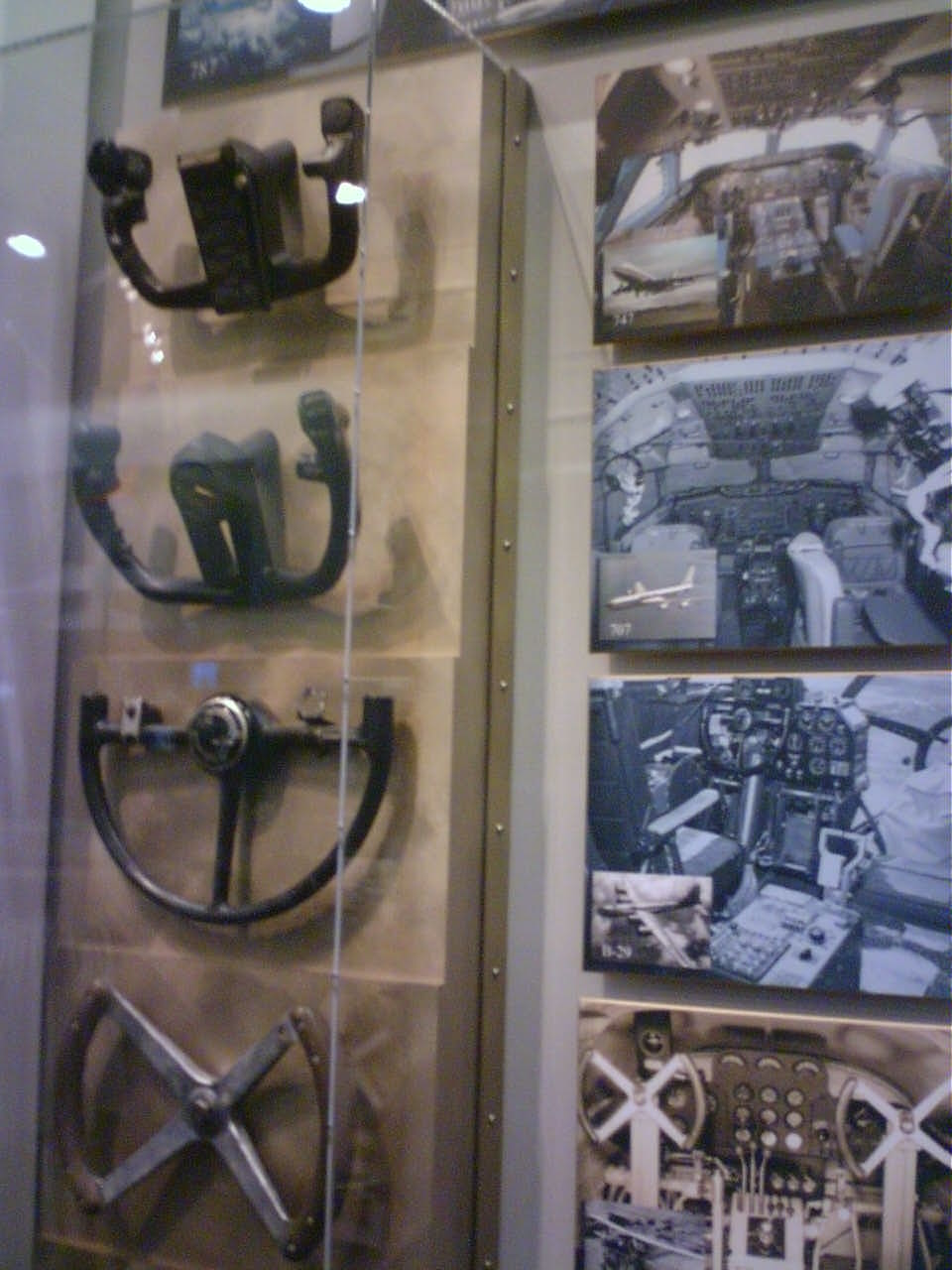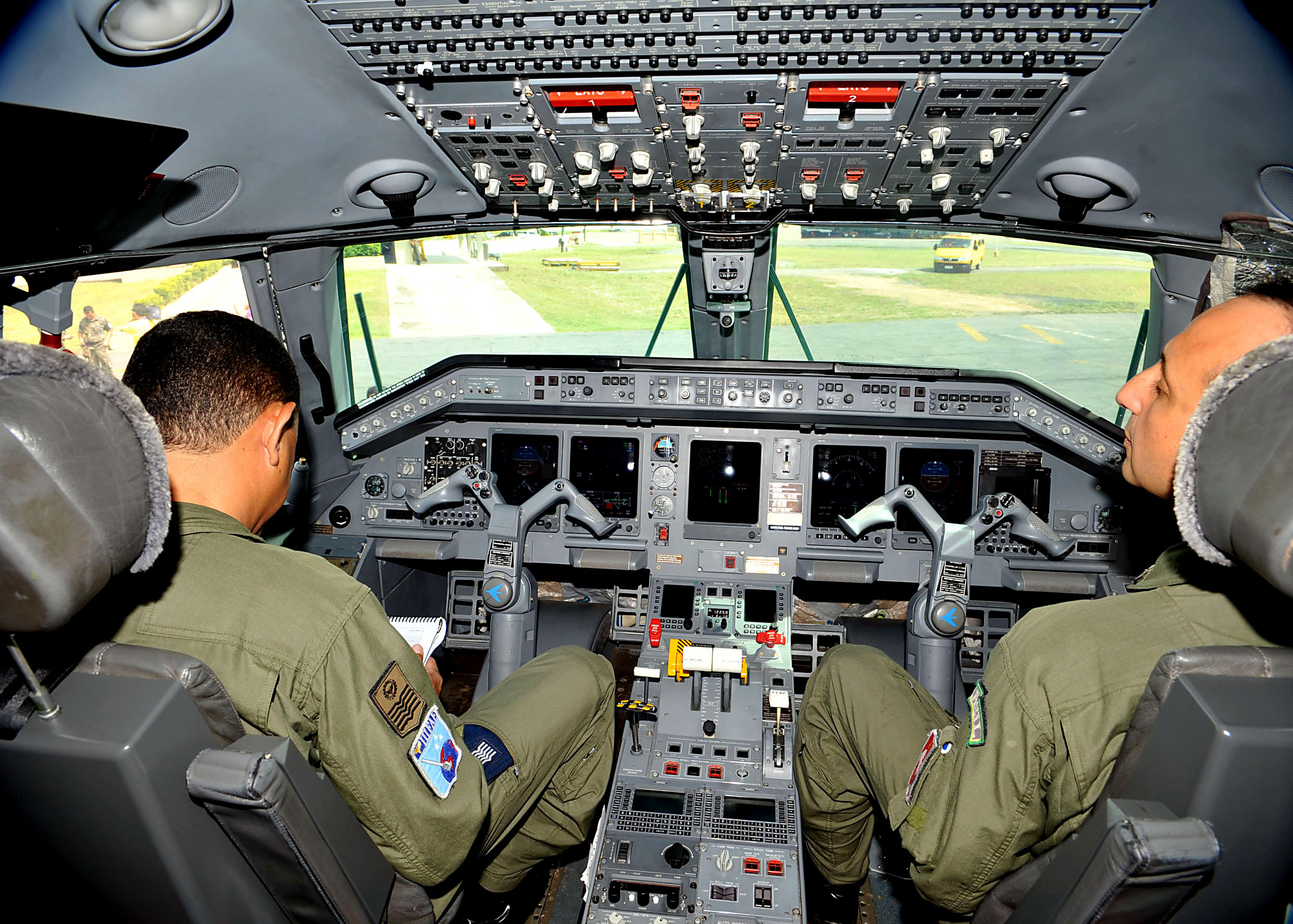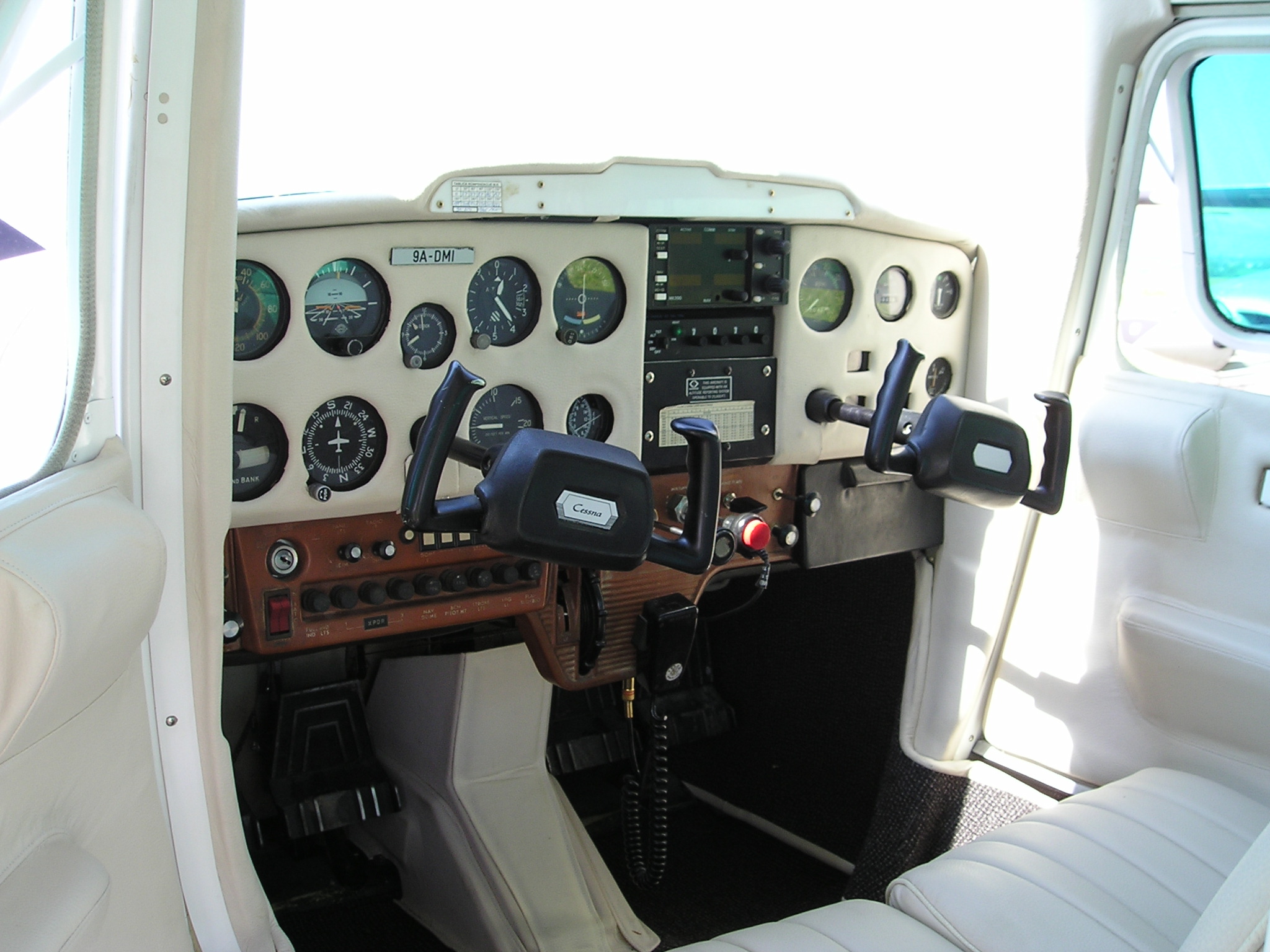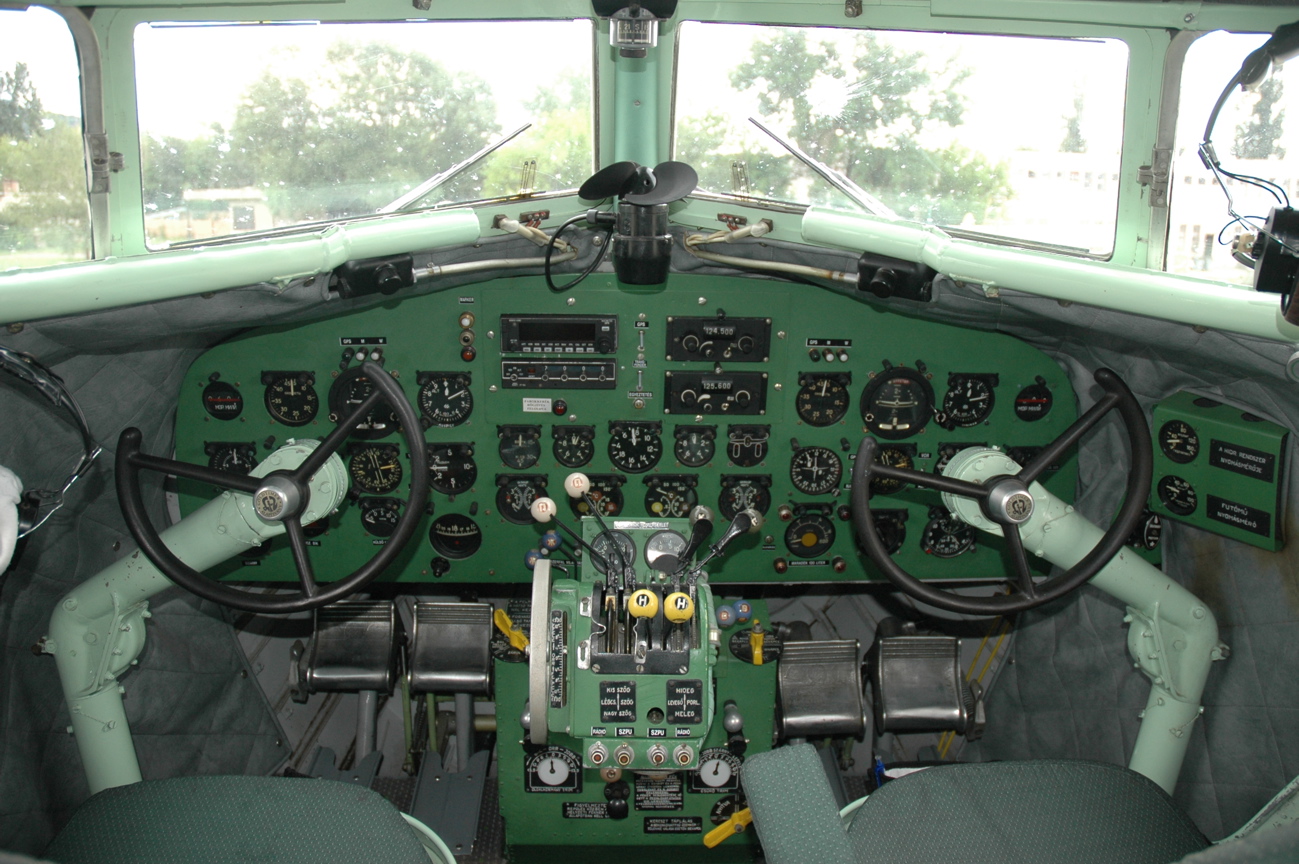Yoke (aeronautics) on:
[Wikipedia]
[Google]
[Amazon]






 A yoke, alternatively known as a control wheel or a control column, is a device used for
A yoke, alternatively known as a control wheel or a control column, is a device used for
Flying the Airbus side stick - the one with the fastest thumb wins!
/ref> There are also computer





piloting
Piloting or pilotage is the process of navigating on water or in the air using fixed points of reference on the sea or on land, usually with reference to a nautical chart or aeronautical chart to obtain a fix of the position of the vessel or air ...
some fixed-wing aircraft.Crane, Dale: ''Dictionary of Aeronautical Terms, third edition'', page 563. Aviation Supplies & Academics, 1997. .
The pilot
An aircraft pilot or aviator is a person who controls the flight of an aircraft by operating its directional flight controls. Some other aircrew members, such as navigators or flight engineers, are also considered aviators, because they a ...
uses the yoke to control the attitude of the plane, usually in both pitch and roll
Roll or Rolls may refer to:
Movement about the longitudinal axis
* Roll angle (or roll rotation), one of the 3 angular degrees of freedom of any stiff body (for example a vehicle), describing motion about the longitudinal axis
** Roll (aviation) ...
. Rotating the control wheel controls the ailerons
An aileron (French for "little wing" or "fin") is a hinged flight control surface usually forming part of the trailing edge of each wing of a fixed-wing aircraft. Ailerons are used in pairs to control the aircraft in roll (or movement around ...
and the roll axis. Fore and aft movement of the control column controls the elevator
An elevator or lift is a cable-assisted, hydraulic cylinder-assisted, or roller-track assisted machine that vertically transports people or freight between floors, levels, or decks of a building, vessel, or other structure. They a ...
and the pitch axis. When the yoke is pulled back, the nose of the aircraft rises. When the yoke is pushed forward, the nose is lowered. When the yoke is turned left, the plane rolls to the left, and when it is turned to the right, the plane rolls to the right.
Small to medium-size aircraft, usually limited to propeller-driven, feature a mechanical system whereby the yoke is connected directly to the control surfaces with cables and rods. Human muscle power alone is not enough for larger and more powerful aircraft, so hydraulic systems are used, in which yoke movements control hydraulic valves and actuators. In more modern aircraft, inputs may first be sent to a fly-by-wire
Fly-by-wire (FBW) is a system that replaces the conventional manual flight controls of an aircraft with an electronic interface. The movements of flight controls are converted to electronic signals transmitted by wires, and flight control ...
system, which then sends a corresponding signal to actuators
An actuator is a component of a machine that is responsible for moving and controlling a mechanism or system, for example by opening a valve. In simple terms, it is a "mover".
An actuator requires a control device (controlled by control signal) an ...
attached to the control surfaces. Yokes may feature a stick shaker
A stick shaker is a mechanical device designed to rapidly and noisily vibrate the control yoke (the "stick") of an aircraft, warning the flight crew that an imminent aerodynamic stall has been detected. It is typically present on the majority of ...
, which is designed to help indicate the onset of stall, or even a stick pusher, which physically pushes the yoke to prevent a stall.
Styles
Yokes come in a variety of shapes and sizes, the most common being of a "U" or "W" design. Some aircraft use a "ram's horn" style yoke, shaped like an "M", such as Embraer aircraft and theConcorde
The Aérospatiale/BAC Concorde () is a retired Franco-British supersonic airliner jointly developed and manufactured by Sud Aviation (later Aérospatiale) and the British Aircraft Corporation (BAC).
Studies started in 1954, and France an ...
. There are some rarer exotic or archaic styles, such as circular or semi-circular designs, much like a steering wheel.
In larger aircraft they are usually mounted on a post protruding vertically from the floor, referred to as a control column. In most other planes, they are mounted on a horizontal tube that comes out of the instrument panel.
In the case of the Cirrus SR20
The Cirrus SR20 is an American piston-engined, four- or five-seat composite monoplane built since 1999 by Cirrus Aircraft of Duluth, Minnesota. The aircraft is the company's earliest type-certified model, earning certification in 1998.
It was t ...
and Cirrus SR22
The Cirrus SR22 is a single-engine four- or five-seat composite aircraft built from 2001 by Cirrus Aircraft of Duluth, Minnesota.
It is a development of the Cirrus SR20, with a larger wing, higher fuel capacity, and a more powerful, 310-horsepo ...
, although the control looks like a side stick
__NOTOC__
A side-stick or sidestick controller is an aircraft control stick that is located on the side console of the pilot, usually on the righthand side, or outboard on a two-seat flightdeck. Typically this is found in aircraft that are equi ...
, it works like a yoke handle (referred to in the industry as a "side yoke"). The Cessna 162
The Cessna 162 Skycatcher is an American side-by-side two-seat, high-wing, strut-braced, tricycle gear light-sport aircraft (LSA) that was designed and produced by Cessna between December 2009 and December 2013. Its intended market was flight ...
uses a similar device.
Advantages and disadvantages
Side-stick
__NOTOC__
A side-stick or sidestick controller is an aircraft control stick that is located on the side console of the pilot, usually on the righthand side, or outboard on a two-seat flightdeck. Typically this is found in aircraft that are equ ...
s and centre-sticks are better for making rapid control inputs and dealing with high g-forces, hence their use in military, sport, and aerobatic aircraft. However, yokes are less sensitive (i.e., more precise) due to a larger range of motion and provide more visual feedback to the pilot.
Most yokes are connected and will both move together, thus providing instant indication to the other pilot when one makes a control input. This is in contrast to some fly-by-wire control sticks that allow each pilot to send different, and sometimes greatly conflicting, inputs. Competing inputs are signaled on Airbus craft.
Yokes take up more room than side-sticks in the cockpit and may even obscure some instruments; by comparison, side-sticks have minimal cockpit intrusion, allowing the inclusion of retractable tray-tables and making it easier to enter/leave small cockpits.
A yoke, unlike a side-stick, may be used comfortably with either hand. This can be useful if one needs to write or manipulate other controls in the cockpit. This advantage is shared with the center-stick.
Ancillary functions
The yoke often incorporates other key functions such as housing thumb or finger buttons to enable theradio
Radio is the technology of signaling and communicating using radio waves. Radio waves are electromagnetic waves of frequency between 30 hertz (Hz) and 300 gigahertz (GHz). They are generated by an electronic device called a transmi ...
microphone, disengage the autopilot
An autopilot is a system used to control the path of an aircraft, marine craft or spacecraft without requiring constant manual control by a human operator. Autopilots do not replace human operators. Instead, the autopilot assists the operator' ...
, and trim the aircraft. In addition, there may be a clipboard, checklist, or chronometer located in the yoke's center.
Alternative control systems
Yokes are not used on all aircraft.Helicopter
A helicopter is a type of rotorcraft in which lift and thrust are supplied by horizontally spinning rotors. This allows the helicopter to take off and land vertically, to hover, and to fly forward, backward and laterally. These attributes ...
s use a cyclic
Cycle, cycles, or cyclic may refer to:
Anthropology and social sciences
* Cyclic history, a theory of history
* Cyclical theory, a theory of American political history associated with Arthur Schlesinger, Sr.
* Social cycle, various cycles in s ...
and the majority of military fighter aircraft use a center or side-stick
__NOTOC__
A side-stick or sidestick controller is an aircraft control stick that is located on the side console of the pilot, usually on the righthand side, or outboard on a two-seat flightdeck. Typically this is found in aircraft that are equ ...
. Some light aircraft use a stick due to pilot preference. The latest Airbus family of passenger jets use a side-stick, similar to a joystick, to actuate control surfaces./ref> There are also computer
input device
In computing, an input device is a piece of equipment used to provide data and control signals to an information processing system, such as a computer or information appliance. Examples of input devices include keyboards, mouse, scanners, cameras ...
s designed to simulate a yoke, intended for flight simulator
A flight simulator is a device that artificially re-creates aircraft flight and the environment in which it flies, for pilot training, design, or other purposes. It includes replicating the equations that govern how aircraft fly, how they rea ...
s.
See also
*Aircraft flight control system
A conventional fixed-wing aircraft flight control system consists of flight control surfaces, the respective cockpit controls, connecting linkages, and the necessary operating mechanisms to control an aircraft's direction in flight. Aircraft ...
* HOTAS
HOTAS, an acronym of hands on throttle-and-stick, is the concept of placing buttons and switches on the throttle lever and flight control stick in an aircraft's cockpit. By adopting such an arrangement, pilots are capable of performing all vit ...
, Hands On Throttle-And-Stick
* Joystick, computer input device
* Steering wheel
References
{{DEFAULTSORT:Yoke (Aircraft) Aircraft controls